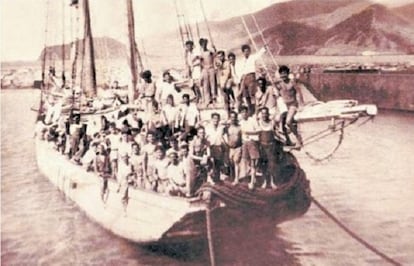When Spaniards were the refugees
The Syrian migrant crisis is drawing comparisons with the exodus during Spain¡¯s Civil War

With tens of thousands of refugees continuing to arrive on the shores of Europe this summer, most of them fleeing the conflict in Syria, the scenes have brought back memories of Spain¡¯s own Civil War to some people.?
¡°Seventy-six years separate these two photographs,¡± writes Antonio Manfredi in the Facebook post below.?¡°The top one is from this summer, showing war refugees in Macedonia. The one below, the same, depicts Spaniards held in French internment camps after the Civil War. What¡¯s the difference? We can¡¯t just be content with our newfound wealth. We have to remember who we were.¡±
In her 2005 study of the Republican exile, La voz de los vencidos (The voice of the vanquished), historian Alicia Alted says around 465,000 Spaniards fled to France between 1936 and 1939. Although around half gradually returned after France surrendered to the Germans in 1940, she puts the total number of those who never came back to Spain at around 220,000.

This photograph, among the many highlighting the similarities between today¡¯s situation and the desperate efforts of Spaniards to flee poverty last century, shows a group of around 100 people who sailed from the Canary Islands to Venezuela without papers in 1949. A decade ago the image was used alongside the slogan ¡°We too were foreigners¡± as part of an awareness campaign created by the regional government of the Canary Islands at a time when large numbers of people were arriving there in rickety boats from West Africa.
EL PA?S journalist Tom¨¢s B¨¢rbulo notes that the men and women aboard the boat were mostly farm laborers who earned around 20 pesetas (12 euro cents) a day working from sunup to sundown, and who paid 4,000 pesetas (€24) to make the crossing.
¡°Juan Azcona, one of the organizers of the voyage, says he had around 20 people staying in his house,¡± says B¨¢rbulo. ¡°Today, under current law, he would be sent to prison for people trafficking.¡±
¡°When those 106 people disembarked in Latin America, Spain was mired in misery and under the boot of Franco, while Venezuela was an emerging economy. Although the difference between the two states was less than say, Nigeria and Spain today, at the time, Spaniards were looking abroad to make a new life, in the same way that people from Africa do today,¡± says B¨¢rbulo.
Refugiados espa?oles a bordo del 'Stanbrook' huyendo hacia Argelia en 1939. #NoSomosGoteras. http://t.co/2mmfop3eah pic.twitter.com/UMWiAx9GZs
— To?o Fraguas (@antoniofraguas) July 21, 2015
Spanish refugees aboard the ¡®Stanbrook¡¯ fleeing to Algeria in 1939.
Used by journalist To?o Fraguas in an article in El Mundo newspaper, this photograph shows the British vessel the Stanbrook, which along with three other steamers and several fishing boats, left the port of Alicante in March 1939, in the final days of the Civil War, with 2,638 people aboard.
When the Stanbrook arrived in the Algerian port of Oran, the French authorities initially refused to allow passengers to disembark, eventually transferring them to internment camps.
Meanwhile, desperate Republicans continued arriving in the Valencia region after those boats left, looking for a way out of Spain. Many committed suicide or drowned after throwing themselves into the sea. London and Paris were disinclined to accept Spanish war refugees, but one country that did step forward was Mexico, then ruled by left-leaning president L¨¢zaro C¨¢rdenas.
On July 1, 1940, C¨¢rdenas said Mexico was prepared to accept all Spanish refugees then in France, and placed them under Mexican diplomatic protection. Spanish refugees continued to travel from France to Mexico until December 1942, when Germany occupied Vichy France, which had been run by a puppet regime headed by Marshal P¨¦tain.
Spanish child refugees in Mexico during the Civil War. The government of President L¨¢zaro C¨¢rdenas took in 480 children.
Spanish Republicans had been escaping to Mexico since 1937, when a boat carrying 463 children left Bordeaux. According to Alted, some of the children were sent without the permission of their parents.
But C¨¢rdenas was criticized by conservatives at home, as well as by labor unions, which feared the new arrivals would drive down wages.
The Mexican authorities tried to vet refugees, allowing only those in with sufficient funds to travel, and keeping them away from Mexico City. The majority of Spaniards who went to Mexico were from the middle classes: teachers, lawyers and other professionals, along with politicians and intellectuals, most of whom did take up residence in the capital. Estimates put the number of Spaniards who left for Mexico after the war at between 20,000 and 24,000.
Spanish war refugees also ended up in Argentina, Chile, Cuba, the Soviet Union, the United States, Dominican Republic and other countries. But many also ended up in French prison camps. Alted quotes Jos¨¦ Ram¨®n y Mena, a Republican who arrived at the Argel¨¨s camp in February 1939: ¡°There were no toilets or running water, the French had installed some water pumps on the beach, using saltpeter, and this created dreadful conditions that led to a dysentery epidemic. People were dropping like flies.¡±
Refugiados. Pero estos son 'nuestros', espa?oles, durante la guerra civil. V¨ªa @emorist pic.twitter.com/vaRgZ6jfeT
— Miguel A. Rodr¨ªguez (@Marodriguez1971) August 23, 2015
Refugees. But these are ¡®ours¡¯ ¨C Spaniards ¨C during the civil war.
France was clearly not prepared to accept the Spanish exiles and, as Alted notes, ¡°was especially interested in forcing people to return to Spain or to move on to other countries.¡±
As a result of France¡¯s refusal to offer the refugees sanctuary, by the end of 1939, growing numbers of Spaniards, particularly women and children, had returned to Spain, leaving between 140,000 and 180,000 in French prison camps. Men aged between 20 and 48 were required to work for the French military authorities, and around 55,000 were enrolled into various organizations, including the French Foreign Legion. When the Germans invaded in the summer of 1940 and France capitulated, many Spaniards became prisoners of war and were sent to Germany to work, says Alted.
But by 1943, Spaniards were being sent from French prison camps to German concentration camps such as Mauthausen, in Austria, as British historian Paul Preston writes in his book The Spanish Holocaust. ¡°On August 20, 1940, a train consisting of cattle wagons left Angoul¨ºme with 927 Spanish refugees aboard,¡± writes Preston. They believed they were being taken to the French-run part of France. ¡°The journey lasted three days and nights, with the refugees unable to sit, with no food or water. On August 24, they arrived at Mauthausen.¡±
Preston tells how the women and children were taken off the train shortly after it left Angoul¨ºme and repatriated to Spain against their wishes. Of the 490 men who arrived to Mauthausen, 397 died there. In total, more than 5,000 Spaniards died in German concentration camps after they were handed over by the French authorities.
Tu suscripci¨®n se est¨¢ usando en otro dispositivo
?Quieres a?adir otro usuario a tu suscripci¨®n?
Si contin¨²as leyendo en este dispositivo, no se podr¨¢ leer en el otro.
FlechaTu suscripci¨®n se est¨¢ usando en otro dispositivo y solo puedes acceder a EL PA?S desde un dispositivo a la vez.
Si quieres compartir tu cuenta, cambia tu suscripci¨®n a la modalidad Premium, as¨ª podr¨¢s a?adir otro usuario. Cada uno acceder¨¢ con su propia cuenta de email, lo que os permitir¨¢ personalizar vuestra experiencia en EL PA?S.
?Tienes una suscripci¨®n de empresa? Accede aqu¨ª para contratar m¨¢s cuentas.
En el caso de no saber qui¨¦n est¨¢ usando tu cuenta, te recomendamos cambiar tu contrase?a aqu¨ª.
Si decides continuar compartiendo tu cuenta, este mensaje se mostrar¨¢ en tu dispositivo y en el de la otra persona que est¨¢ usando tu cuenta de forma indefinida, afectando a tu experiencia de lectura. Puedes consultar aqu¨ª los t¨¦rminos y condiciones de la suscripci¨®n digital.









































